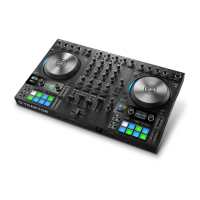Chapter 2 15
Analyzing Genre
Genre is used to describe the different categories of music that you might play and are
provided by the songs producers upon purchase. Some common genres played by a DJ
include the following:
• House
• Electro House
• Dubstep
• Drum and Bass
• Breaks
• Glitch Hop
Genre is important because mixing songs with a similar genre will provide more
continuity to your mixing.
Most genres are divided by their different beats per minute, style, or time of creation.
Beats per minute is the most common difference between electronic genres.
Analyzing Beats per Minute (BPM)
Beats per minute (also known as tempo, or BPM) describes the pace at which the
common down beats of a song are played and is analyzed in Traktor 2 along with your
track collection and upon loading a song into a deck.
Beats per minute (BPM) is very important to mixing songs. Songs with the same BPM
play back at the same rate as one another, making it easier to mix between songs.
The common range for BPM is 70-200. Some tracks will be analyzed at 70 BPM but can
also be played at the same speed as a 140 BPM with the use of the “grid” menu (more on
the grid menu in chapter 3).
Analyzing Key
Key is the basic melodic structure of any given song and ranges from A major/minor to
G major/minor.
Analyzing a songs key can be done with various other programs, one of which is called
Mixed in Key (Figure 19). Mixed in Key analyzes a songs key and stores it in the browser
field called “comments” which can be later used to sort songs by their key. Mixed in Key
expresses key by using what is called the “Camelot Wheel” (Figure 20). The rules behind

